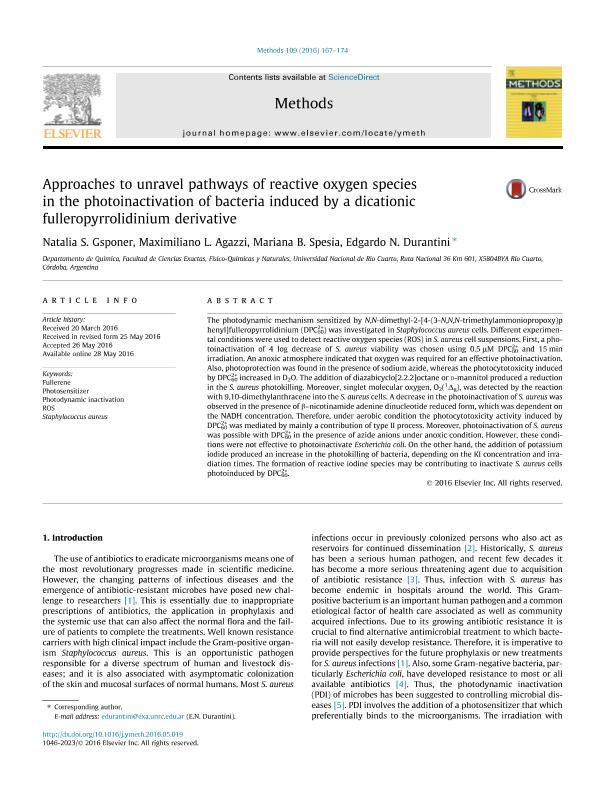Artículo
Approaches to unravel pathways of reactive oxygen species in the photoinactivation of bacteria induced by a dicationic fulleropyrrolidinium derivative
Gsponer, Natalia Soledad ; Agazzi, Maximiliano Luis
; Agazzi, Maximiliano Luis ; Spesia, Mariana Belen
; Spesia, Mariana Belen ; Durantini, Edgardo Néstor
; Durantini, Edgardo Néstor
 ; Agazzi, Maximiliano Luis
; Agazzi, Maximiliano Luis ; Spesia, Mariana Belen
; Spesia, Mariana Belen ; Durantini, Edgardo Néstor
; Durantini, Edgardo Néstor
Fecha de publicación:
15/10/2016
Editorial:
Academic Press Inc Elsevier Science
Revista:
Methods
ISSN:
1046-2023
e-ISSN:
1095-9130
Idioma:
Inglés
Tipo de recurso:
Artículo publicado
Clasificación temática:
Resumen
The photodynamic mechanism sensitized by N,N-dimethyl-2-[4-(3-N,N,N-trimethylammoniopropoxy)phenyl]fulleropyrrolidinium (DPC602+) was investigated in Staphylococcus aureus cells. Different experimental conditions were used to detect reactive oxygen species (ROS) in S. aureus cell suspensions. First, a photoinactivation of 4 log decrease of S. aureus viability was chosen using 0.5 μM DPC602+ and 15 min irradiation. An anoxic atmosphere indicated that oxygen was required for an effective photoinactivation. Also, photoprotection was found in the presence of sodium azide, whereas the photocytotoxicity induced by DPC602+ increased in D2O. The addition of diazabicyclo[2.2.2]octane or D-mannitol produced a reduction in the S. aureus photokilling. Moreover, singlet molecular oxygen, O2(1Δg), was detected by the reaction with 9,10-dimethylanthracene into the S. aureus cells. A decrease in the photoinactivation of S. aureus was observed in the presence of β–nicotinamide adenine dinucleotide reduced form, which was dependent on the NADH concentration. Therefore, under aerobic condition the photocytotoxicity activity induced by DPC602+ was mediated by mainly a contribution of type II process. Moreover, photoinactivation of S. aureus was possible with DPC602+ in the presence of azide anions under anoxic condition. However, these conditions were not effective to photoinactivate Escherichia coli. On the other hand, the addition of potassium iodide produced an increase in the photokilling of bacteria, depending on the KI concentration and irradiation times. The formation of reactive iodine species may be contributing to inactivate S. aureus cells photoinduced by DPC602+.
Archivos asociados
Licencia
Identificadores
Colecciones
Articulos(CCT - CORDOBA)
Articulos de CTRO.CIENTIFICO TECNOL.CONICET - CORDOBA
Articulos de CTRO.CIENTIFICO TECNOL.CONICET - CORDOBA
Citación
Gsponer, Natalia Soledad; Agazzi, Maximiliano Luis; Spesia, Mariana Belen; Durantini, Edgardo Néstor; Approaches to unravel pathways of reactive oxygen species in the photoinactivation of bacteria induced by a dicationic fulleropyrrolidinium derivative; Academic Press Inc Elsevier Science; Methods; 109; 15-10-2016; 167-174
Compartir
Altmétricas



